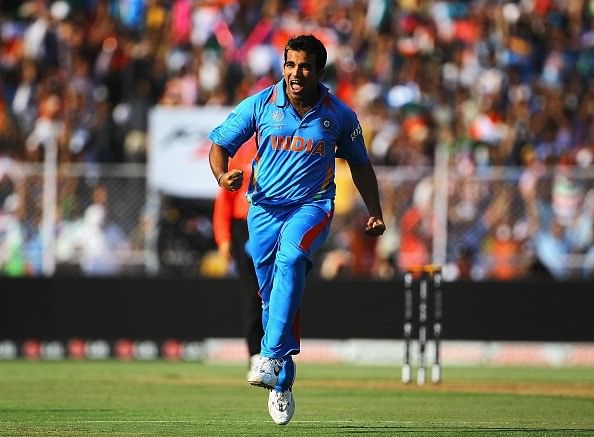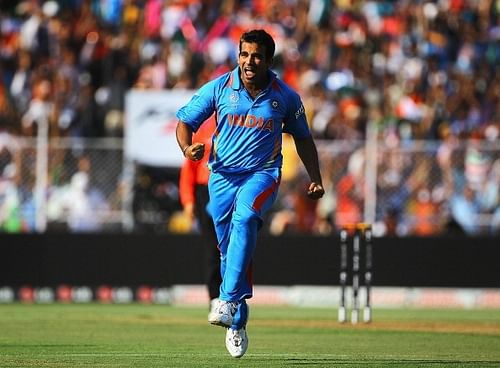
Interview with Zaheer Khan: "I always focused on putting the ball in the right areas and bowling with supreme control"

Zaheer Khan is an anomaly in Indian cricket in so many ways. Longevity, tactical acuity, and splendiferous success are not the virtues one normally associates with an Indian fast bowler. With 311 scalps in Tests and 282 in the ODIs, Zaheer was the fulcrum of India’s bowling attack for over a decade and orchestrated a string of glorious victories for his country.
In an exclusive interview, he looks back at his cricketing career and expounds the insights on a range of subjects. Excerpts:
What prompted you to become a fast bowler? Who were your childhood heroes you looked up to?
I always had the passion for the game and used to watch it only the TV but at that time, I was studying to become an Engineer and did not think of becoming a cricketer. It was only when I came to Mumbai in 1996 that I discovered that I had the wherewithal to become a fast bowler.
Soon after, I joined the MRF Pace Academy where I trained under Dennis Lillee. I had read his book ‘The Art of Fast Bowling’ and it really fascinated me. There’s a huge video library at the MRF Pace Academy where one can watch videos of all great fast bowlers. So I picked up different things from different fast bowlers. I loved Allan Donald’s run-up and Richard Hadlee’s unerring accuracy.
What was the feeling like before your first international match? Sourav Ganguly is known to back and prop up youngsters as the captain. Did he say anything to you?
Like any other youngster, I was extremely excited but at the same time trifle jittery too. I remember I could not sleep properly before my first international match. Ganguly did not tell me anything, in particular, but he gave the ball to me to bowl the first over. That showed he had faith in me. Thankfully, I bowled well in the match and that gave me a lot of confidence.
Your international career can be divided into two phases: pre-2005 and post-2005. What changes did you incorporate in your bowling to emerge as the spearhead of the Indian attack?
I was thinking of shortening my run-up from 2-3 years before 2005, but I did not get adequate time. When one is playing international cricket, the mind is completely occupied and one is busy round the clock owing to the tight cricket schedule. Sometimes I was bowling with the short run-up in the nets but one cannot make radical changes while constantly playing cricket. So when I had time on hands, I started working on my run-up and shortened it. I realized that I would be more effective with this run-up.
Also, with 5 years of experience under my belt, I had become more astute in terms of tactics and nuances of fast bowling. I learned to bowl with more control and not to spray the ball around. I also got to know about my bowling more and worked on the grey areas.
The County stint with Worcestershire surely helped? You came back as a supremely skillful and shrewd bowler…
I always believed that match practice is the best practice. Playing County cricket allowed me to try out different things in different conditions. By then I had started bowling with a shorter run-up and was eager to experiment with new things I had conceived and learned. In that way, playing county cricket did a lot of good to me and my bowling. I also learned to adapt to different conditions.
You were the architect of India’s victory in England in the 2007 Test series. Did the experience of having played in county cricket come in handy?
Yes. Having played county cricket, I was aware of the conditions and how to go about bowling on these pitches. Also, I was bowling quite well during that period and had become a more competent and canny bowler than I was earlier. Before the England tour, I had done well in the Test series in South Africa. So, I was in really good rhythm and form.
How do pace bowlers discover new variations like the ‘Knuckle Ball’ which you discovered?
It happens when you learn more about the craft with experience. So when you are in complete control of your bowling and understand the craft, you start thinking about trying out a few new things in the nets. So when something proves salutary then one practices it for a while to master it and then use it in international matches.
In the case ball of ‘Knuckle Ball’, I found out in the nets that most batsmen were not able to read it properly and were deceived but it as it comes slower off the surface. Hence, I deceived to use it in international matches.
Who were the toughest batsmen to bowl to? Did any batsman intimidate you or demolish your confidence?
Honestly, I always focused on putting the ball in right areas and bowling with supreme control. I did not think much about who I am bowling to.
According to you, which was the best bowling spell of your career when you were able to do things exactly the way you conceived?
I reckon I bowled some really spiffing spells post 2005. It is hard to pick one. There were some spells in which I did not chalk up a bag full of wickets but in terms of impact and quality, they are right at the top of the heap.
You played under two successful captains – Sourav Ganguly and MS Dhoni. How different and similar were they from the perspective of a fast bowler?
Look, comparisons are odious. Each captain has his own style and approach. There are many discerning people out there who analyze captaincy. MS was quite pro-active in the limited-overs cricket where he pushed the boundaries and made things happen. On the other hand, I found Ganguly more percipient and clued-up in Test matches.
Rahul Dravid was the most methodical skipper I played under. He was extremely perceptive and assiduous in forging strategies.
Dhoni said that in terms of being significant to the team, Zaheer Khan is the Sachin Tendulkar of Indian bowling. Your thoughts?
To be spoken in the same breath as Sachin is the best compliment any cricketer can receive. He is the greatest cricketer of our generation who set new benchmarks of excellence. I’m elated that MS thinks this way. I would like to thank him for such a gracious acknowledgment of my services to Indian cricket.
In the last 20 years, a string of Indian fast bowlers demonstrated promise and spark in the initial stage of their careers but soon faded away. You are the only exception. What are the reasons behind your longevity and success?
One of the reasons could perhaps be that Indian pitches are not conducive to fast bowling. But that cannot be an excuse. I think constantly re-inventing yourself is the key of survival as well as success. Also, one needs to be completely focused and have a receptive mind. It is important to keep learning and evolving as a fast bowler. Fitness is also a crucial factor. As far as longevity is concerned, I must confess that one needs a bit of luck too. I guess I was a bit luckier than my contemporaries.
The current crop of Indian fast bowlers rarely bowls yorkers; something which you did quite effectively in your pomp
I think bowling yorkers came naturally to me. There are some things which come naturally to you. I used them effectively during the slog overs in the ODIs. I see no reason why current Indian fast bowlers cannot bowl yorkers. Surely one needs to practice a lot to master things which do not come naturally to you.
You also need to understand that one cannot keep on bowling yorkers all the time, especially in Test matches. It can only be used as a surprise weapon to flummox batsmen.
The general consensus is that you should be the bowling coach of Indian team given your extensive experience and cognizance of the craft.
I used to pass on the suggestions to younger fast bowlers even while I was playing. They can always call me or talk to me whenever they need any advice. As for taking up the position of bowling coach of Indian team, I have not thought about it as yet.
Last Question… Ganguly, Virender Sehwag, and Harbhajan Singh have gone on record to say that former Indian coach Greg Chappell was the worst thing to have happened to Indian cricket. He didn’t seem to be too fond of you either. How was your equation with him?
(Laughs)… Navneet, as you can see that at present I am in a happy state of mind reminiscing my cricketing Odyssey. Let’s not talk about Greg Chappell.